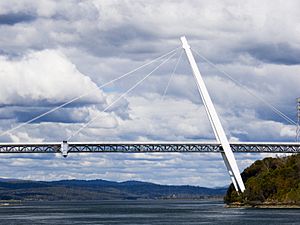Batman Bridge facts for kids
The Batman Bridge is a really cool bridge in northern Tasmania, Australia. It crosses the Tamar River, about 30 kilometers (19 miles) north of a city called Launceston. The bridge was officially opened on May 18, 1968, by Eric Reece, who was the Premier of Tasmania (like the leader of the state government).
When it was built, the Batman Bridge was super special! It was one of the very first cable-stayed truss bridges in the whole world. This means it's held up by strong cables connected to a tall tower. The bridge helps people travel easily between the north-east and north-west parts of Tasmania. It was named after John Batman, an important early explorer and the person who helped start the big city of Melbourne.
How the Bridge Works
The Batman Bridge is held up by strong cables. These cables are connected to a giant A-shaped tower on the west side of the river. This tower is about 96 meters (315 feet) tall! What's really interesting is that the tower isn't straight up; it actually leans out over the river by about 30 meters (100 feet).
The whole bridge is about 432 meters (1,417 feet) long. The main part that goes over the river is about 215 meters (706 feet) long. On the western side, there's another section that's about 55 meters (180 feet) long. On the eastern side, the bridge connects to the land with four continuous sections called viaducts. The bridge is also quite high above the water, about 29 meters (94 feet) above the highest tide. The bridge deck is made of steel and has space for two lanes of traffic, plus walkways on both sides for people to use.
The Strong A-Frame Tower
The Batman Bridge was built at the narrowest part of the Tamar River, in an area known as Whirlpool Reach. However, the ground on the east side of the river was very soft clay, which wasn't strong enough to support the bridge's weight.
Because of this, the main A-frame tower was built on the west side. This huge tower goes deep into the ground, about 21 meters (70 feet) below the surface, reaching the solid bedrock (the hard rock layer under the soil). To make it even stronger, steel cables are cemented into tunnels drilled into this bedrock. This strong tower holds up the entire weight of the bridge section that crosses the river.
Images for kids





